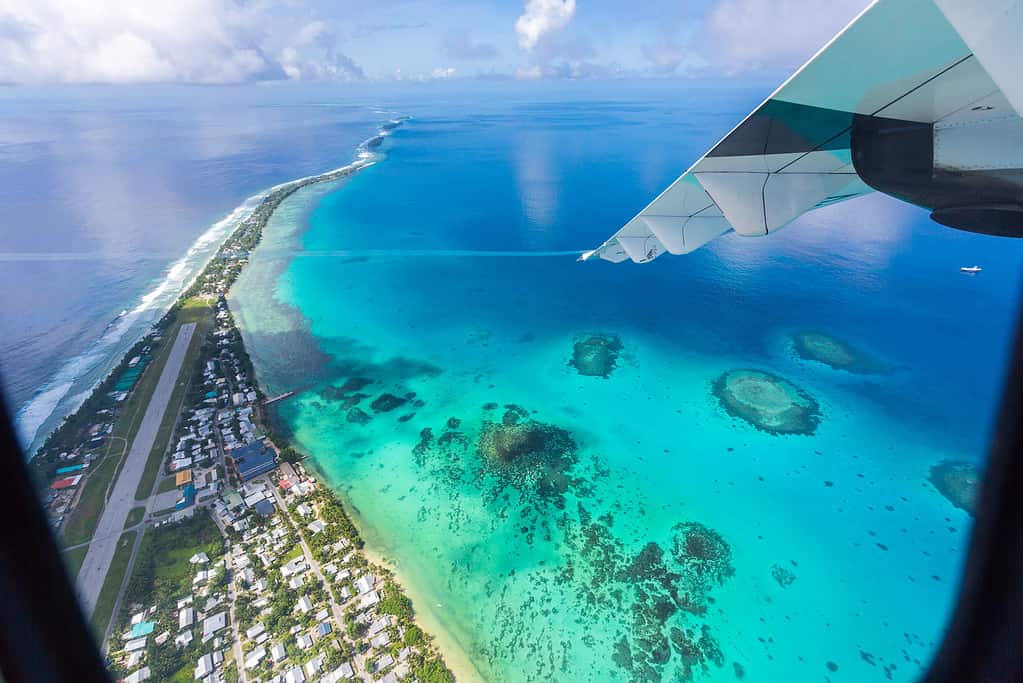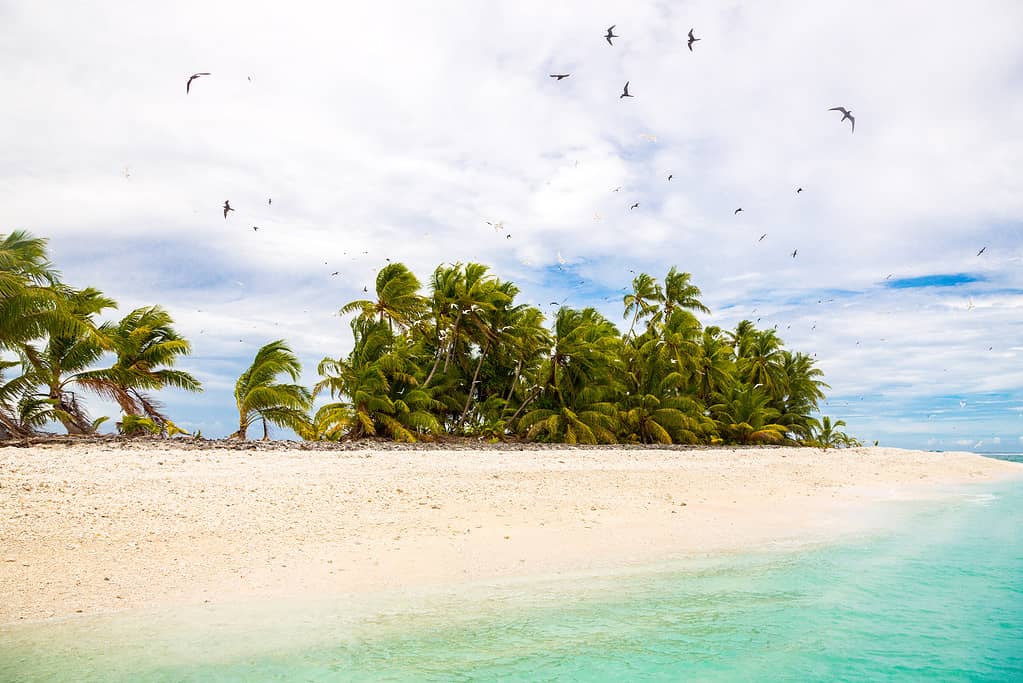When you think of the most picturesque nations in the world, you think of Spain or France. Maybe you’re more of a beach person, so you think of Mexico or the Maldives. You just don’t think of an island nation in the middle of the Pacific called Tuvalu. In fact, Tuvalu is the least visited country on Earth.
What if we told you Tuvalu is a picturesque paradise? What if we told you that Tuvalu is so beautiful that you’ll want to grab your bags in an instant? It’s quite hard to do since the only flights to Tuvalu run twice a week from Fiji. We’re going to take a look at why Tuvalu is the least visited country in the world. We’re also going to sprinkle in some history of the island nation and if you happen to visit, fun activities you can do.
Why Is Tuvalu the Least Visited Country?

Tuvalu is one of the world’s smallest countries with only Nauru, Monaco, and Vatican City smaller.
©mbrand85/iStock via Getty Images
Tuvalu is a Polynesian nation consisting of nine islands in the Pacific Ocean. Kiribati and Fiji are quite close to the island country. Its gorgeous views of the ocean are to die for. When you see pictures, you think that Tuvalu must be swarming with people. But it’s actually the least visited country on Earth.
The question is why? There are two reasons. One of them is somewhat minor: there are only two flights per week to Tuvalu and the only place you can get a flight is from Fiji. There are weekly flights from Kiribati, but they have been unreliable.
Reason #2 is extremely major, unfortunate, and very sad. Tuvalu is sinking and scientists believe that Tuvalu will be mostly underwater by 2100. Due to climate change, the sinking is happening faster and faster. Tuvaluans have started with international projects to reclaim land.
Using Ocean Law
September 2023 marked a monumental time for Tuvalu and island nations throughout the world. According to Euronews, Tuvalu and Antigua and Barbuda brought their case to an international court to “consider whether carbon emissions absorbed by the sea should be considered marine pollution, and what obligations nations have to protect the marine environment.”
The ocean absorbs up to 25% of carbon emissions and islands around the world are paying a hefty price. The international court will issue its opinion in 2024.
Tuvalu’s Geography

There are no ATMs anywhere in the country and it does not take credit cards.
©Dmitry Malov/iStock via Getty Images
Tuvalu consists of three reef islands: Nanumanga, Niutao, and Niulakita, and six atolls: Funafuti, Nanumea, Nui, Nukufetau, Nukulaelae, and Vaitupu. Unfortunately, the islands have poor soil, so not much can grow on the islands. Coconut trees, bananas, and taro can thrive on the island, but they import much of their goods.
Climate of Tuvalu
The climate of Tuvalu is straightforward. There is a wet season from November to April and a dry season from May to October. The country is plagued with heavy rain, as well as El Niño and La Niña effects. This brings in tropical storms and cyclones constantly, which further puts pressure on the small islands.
Unfortunately, as it’s stated above, climate change is completely decimating the country. The sea level rise is taking away land, and much faster than ever before. The country experiences king tides, which are higher than normal tides, furthering the country’s sinking.
Wildlife in Tuvalu
Because Tuvalu is in the middle of the Pacific, many of the animals found in Tuvalu are marine animals. There are various species of whales including pilot whales, sperm whales, and orcas. False killer whales, a species of dolphin, are also found swimming near Tuvalu. Many species of birds make Tuvalu home, like the white-tailed tropicbird, the Pacific reef heron, the red-footed booby, and the Pacific imperial pigeon.
Luckily, there’s a conservation area on the biggest atoll called Funafuti, which is the capital of Tuvalu. The conservation area is encapsulated in the western area of the capital city where an abundance of biodiversity lives. There are numerous species of coral, fish, algae, and even green sea turtles that breed in the area.
When it comes to flora, there are over 300 species of plants. The most common trees living on the islands are coconut trees, papaya trees, and saltbush, among others.
History of Tuvalu
Polynesians inhabited the area for thousands of years until the first European explorers arrived in Tuvalu in 1569. Great Britain claimed the islands as theirs in the late 19th century and established a presence in the area. In the 1970s, Tuvalu finally claimed independence from the UK and became an independent nation, although they were still part of the Commonwealth.
Things To Do in Tuvalu

Tuvalu joined the United Nations on September 5, 2000, the 189th nation to join.
©Dmitry Malov/iStock via Getty Images
If you want to visit Tuvalu and have the means necessary to do so, there are several things you can do to enjoy yourself. Many of them are outdoor activities, and of course, since it’s an island, you will be hanging out at the beach for most of your time.
Get your equipment and you can fish or snorkel in the lagoon. The ocean, it is said, is far too dangerous to swim in, so, for safety reasons, it’s better to stick to the lagoon for your activities. You can also go watch a game of kilikiti, which is a Tuvaluan form of cricket.
For some indoor activities, you check out the Philatelic Bureau and the University of the South Pacific Center. There you can see a great stamp collection and even get some for yourself. You can also read countless books on Tuvalu and its history and culture.
What To Eat in Tuvalu
If you’re fortunate to visit Tuvalu, there are many things to eat that are unique to its culture. In fact, Tuvaluans are actively preserving their culture and heritage in the metaverse to ensure it doesn’t go extinct along with the island.
You have to start by eating the country’s national dish, which is pulaka. Pulaka is similar to the taro, but it’s colloquially called “swamp taro” because it can grow in pits below sea level. Make sure you wash that down with toddy, which is a sort of coconut liquid. And for dessert, you can enjoy the delectable fekei. It’s grated pulaka with coconut cream!
If you’re craving something meatier for dinner, make sure you get a Tuvalu tuna, which is a curry dish. Just imagine some jasmine rice along with tuna steaks mixed with coconut milk, curry powder, and soy sauce. Or you can feast on a coconut crab curry. Mmm, good!
Fast Facts About Tuvalu

Its country code domain ending is .tv extension, which has been quite great for the island nation economically and financially.
©Tamara_frvc/iStock via Getty Images
- Capital: Funafuti
- Population: 11,900
- Prime Minister: Kausea Natano
- Area: 10 square miles (26 square km)
- Official Languages: Tuvaluan and English
Conclusion
And there you have it, the least visited country on Earth is definitely a picturesque paradise, but it’s also a country in danger. Tuvalu is sinking and climate change is accelerating to a degree that most of the island will be underwater by 2100. It’s an inevitable reality and one that the government is actively trying to delay. They are preserving their history, culture, and nation in a digital metaverse.
There’s not much we can do, although the country is trying to reclaim land and they also have the first ocean law case in international court. For now, we do our part to save the environment and delay the effects of climate change.
The photo featured at the top of this post is © Maximilien Leblanc/iStock via Getty Images
Thank you for reading! Have some feedback for us? Contact the AZ Animals editorial team.







